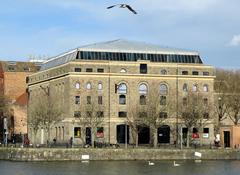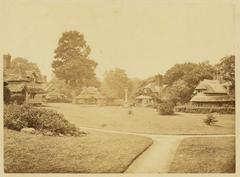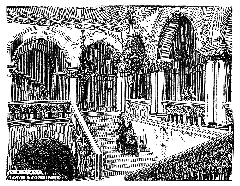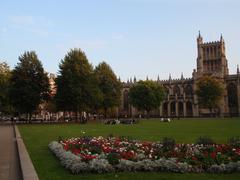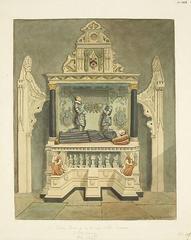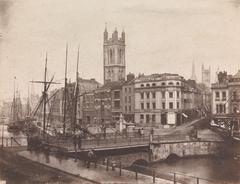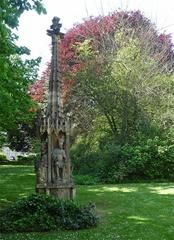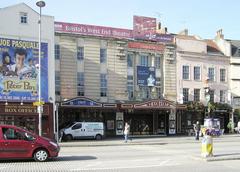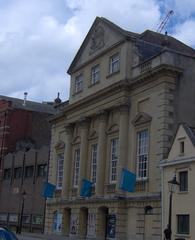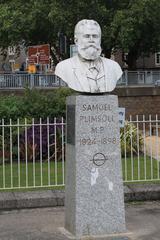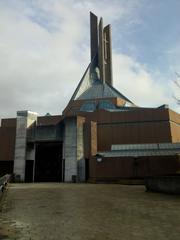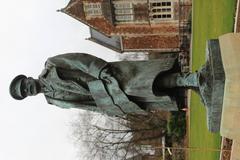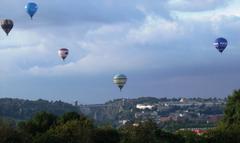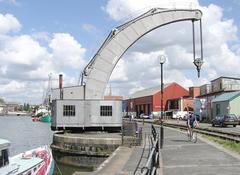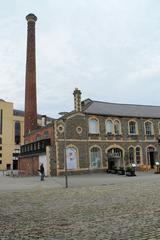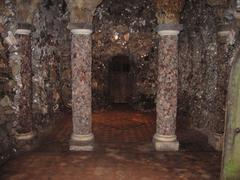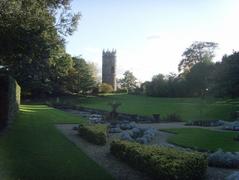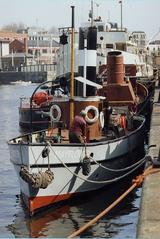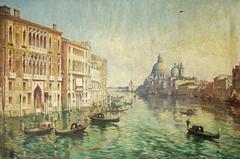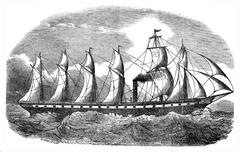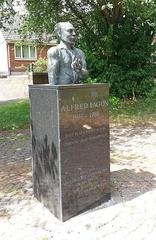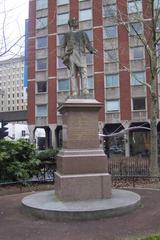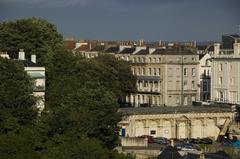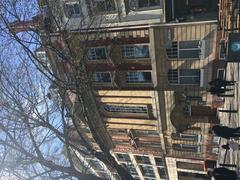
Blaise Castle Estate: Visiting Hours, Tickets, and Attractions in Bristol
Date: 04/07/2025
Introduction
Blaise Castle Estate, located on the northwestern edge of Bristol, is a remarkable historical site offering visitors a unique blend of Gothic Revival architecture, sweeping parkland, and centuries of British history. Famous for its iconic castle folly, neoclassical mansion, and the picturesque Blaise Hamlet, the estate provides a rich visitor experience—whether you’re a history enthusiast, a nature lover, or planning a family day out.
This comprehensive guide covers everything you need to know: opening hours, ticketing, accessibility, travel tips, attractions, and answers to frequently asked questions. For the latest details, consult the National Trust, Friends of Blaise, and Bristol City Council websites.
Contents
- Historical Overview
- Medieval Origins and Early Development
- The Picturesque Movement and Thomas Farr
- The Harford Era and Landscape Innovation
- Blaise Hamlet and Estate Buildings
- Literary Significance
- Public Ownership and Preservation
- Planning Your Visit
- Opening Hours and Tickets
- Accessibility and Facilities
- Getting There and Parking
- Travel Tips
- Events and Guided Tours
- Main Attractions
- Blaise Castle Folly
- Blaise Castle House and Museum
- Blaise Hamlet
- Parkland, Trails, and Nature Features
- Playgrounds and Family Activities
- Visitor FAQs
- Summary and Recommendations
- Sources
Historical Overview
Medieval Origins and Early Development
The land that now forms Blaise Castle Estate was once part of the ancient manor of Henbury. Named after Saint Blaise, a 4th-century Armenian bishop, the estate reflects the medieval tradition of naming places after saints (National Trust).
The 18th Century: The Picturesque Movement and Thomas Farr
Thomas Farr, a Bristol merchant enriched by the sugar trade, purchased the estate in 1762. Inspired by the Picturesque Movement, he commissioned Robert Mylne to design the decorative Gothic Revival folly, completed in 1766. The castle served as an eye-catching hilltop feature and a lookout over the River Severn. Farr’s fortunes later declined, leading to the sale of the estate (Visit Gardens).
The Harford Era: Architectural Flourishing and Landscape Innovation
John Scandrett Harford, a Quaker banker, acquired the estate in 1789, replacing the Tudor house with a neoclassical mansion designed by William Paty. Harford enlisted the renowned landscape designer Humphry Repton, who enhanced the estate with color-coded drives and harmonized the natural and designed features (National Trust).
Blaise Hamlet and Estate Buildings
In the early 19th century, Harford commissioned John Nash and George Repton to create Blaise Hamlet—a cluster of nine thatched cottages for retired estate workers, now managed by the National Trust. Other notable estate features include The Dairy, the Orangery, ornamental gardens, and garden follies like the Nymph’s Cave and Woodman’s House (Visit Gardens).
Literary and Cultural Significance
Jane Austen immortalized Blaise Castle in Northanger Abbey as “the finest place in England—worth going fifty miles at any time to see” (BBC Bristol). The estate’s picturesque landscape, dramatic gorges, and wildflower meadows have inspired generations of artists and writers.
20th Century to Present: Public Ownership and Preservation
Blaise Hamlet was donated to the National Trust in 1943. The house and parkland are now managed by Bristol City Council, ensuring the estate’s preservation and accessibility for the public (National Trust). Community efforts, especially after a 1950s fire, have played a key role in preserving the site for future generations (Friends of Blaise).
Planning Your Visit
Opening Hours and Tickets
- Estate Grounds: Open daily from 7:30 am until dusk (seasonal closing times apply).
- Blaise Museum: Open Wednesday to Sunday, 10:00 am–5:00 pm (check for seasonal variations).
- Castle Folly: Open to the public on select Sundays during summer months (bristol.rocks).
- Admission: Entry to parkland and outdoor attractions is free. Tickets may be required for museum entry, special events, or castle tours; discounts are available for children, seniors, and National Trust members.
Always check the latest schedules and ticketing details on the official website.
Accessibility and Facilities
- Wheelchair Access: Main entrance, museum, café, and toilets are accessible.
- Paths: Many main routes are tarmacked and suitable for wheelchairs and strollers; woodland trails may be uneven.
- Toilets: Accessible toilets with grab rails and baby changing facilities are near the entrance.
- Parking: Free parking at Kings Weston Road (main entrance, with five disability bays) and The Dingle (direct woodland access).
Getting There
- By Car: Use postcode BS10 7QS; well-signposted from Bristol and M5 (junction 17 via A4018).
- By Public Transport: Buses from Bristol city center stop near the estate; check current routes via Traveline South West.
- Cycling: Bike racks available on site.
Travel Tips
- Best Time to Visit: Late spring for rhododendron blooms; summer for events and castle openings.
- Footwear: Wear sturdy shoes for woodland walks or castle hill climbs.
- Dogs: Welcome on leads in parkland; off-lead areas and water points available.
Events and Guided Tours
Blaise Castle Estate hosts seasonal events, guided walks, and family-friendly activities. Check noticeboards on-site or the official website for upcoming events and booking details.
Main Attractions
Blaise Castle Folly
The estate’s landmark Gothic Revival folly, completed in 1766, sits atop a wooded hill offering panoramic views over Bristol, the Avon Gorge, the Cotswolds, and South Wales (bristolguide.co.uk; wikipedia). The castle is usually open to visitors on select Sundays in summer. Sensible footwear is advised for the woodland walk to the top (bristol.rocks).
Blaise Castle House and Museum
The neoclassical mansion, built in the late 18th century for John Harford, now houses the Blaise Museum (historyhit.com). Exhibits explore Bristol’s social history, with displays of toys, costumes, household artifacts, model trains, and art. The Picture Room features paintings and photographs documenting local heritage (historytools.org).
Blaise Hamlet
A short walk from the main house, Blaise Hamlet showcases nine picturesque thatched cottages designed by John Nash and George Repton in 1811 for retired estate workers (wikipedia). While the cottages themselves are private residences, the green is open for visitors and photography (historyhit.com).
Parkland, Trails, and Nature Features
With 650 acres of registered parkland, the estate offers diverse landscapes: ancient woodlands, meadows, dramatic gorges, and formal gardens (bristol.gov.uk). Popular walking routes include Castle Walk, Gorge Walk, and Kings Weston Down Walk. Hazel Brook, limestone caves, and seasonal wildflowers add to the natural appeal (realgirlswobble.com).
Playgrounds and Family Activities
Two well-equipped playgrounds cater to children of all ages—one for toddlers and another for older children with zip wires and climbing frames (bristol.rocks; bristolpost.co.uk). Hazel Brook provides safe paddling, and ample green space allows for picnics and outdoor play.
Café and Amenities
A café near the main entrance serves hot and cold food, drinks, and ice creams, with accessible indoor and outdoor seating. Public toilets, baby changing, and cycle racks are available.
Events and Community Activities
Regular events include Parkrun, community workshops, and seasonal guided walks (bristolguide.co.uk). Noticeboards and the website provide up-to-date schedules.
Visitor FAQs
What are the opening hours?
The estate is open daily from 7:30 am until dusk. The museum opens Wednesday–Sunday, 10:00 am–5:00 pm; castle access is typically limited to selected summer Sundays.
Is there an entry fee?
Parkland and outdoor attractions are free. Some special events, museum entry, or castle tours may require tickets.
Are dogs allowed?
Dogs are welcome; leads are required in certain areas. Assistance dogs are permitted throughout.
Is the estate wheelchair accessible?
Main areas, including the museum and café, are wheelchair accessible. Some woodland trails may be uneven.
Are guided tours available?
Guided walks and tours are offered during selected events and holidays. Check the estate’s website for details.
Summary and Visitor Recommendations
Blaise Castle Estate is a jewel of Bristol’s heritage, blending historical grandeur, architectural intrigue, and natural beauty within its vast grounds. From the Gothic Revival folly to the neoclassical mansion, the storybook cottages of Blaise Hamlet, and the sweeping parkland filled with wildlife, the estate promises an enriching experience for all visitors.
To maximize your visit:
- Check current opening hours and event schedules on official sites.
- Book tickets in advance for special tours or events during peak times.
- Download the Audiala app for guided tours and insider tips.
- Wear sturdy footwear for woodland walks and castle hill climbs.
- Bring a camera to capture panoramic views and unique architectural features.
Whether you’re exploring local history, enjoying a family day out, or seeking tranquil nature walks, Blaise Castle Estate is a must-see destination in Bristol.
Sources and Official Links
- Blaise Castle Estate Visiting Hours, Tickets, and Historical Guide: Explore Bristol’s Iconic Heritage Site, National Trust (https://www.nationaltrust.org.uk/visit/bath-bristol/blaise-hamlet)
- Blaise Castle Visiting Guide: History, Tickets, Hours & Things to Do at Bristol’s Historic Estate, Friends of Blaise (https://friendsofblaise.co.uk/castle-history/)
- Explore Blaise Castle Estate: Visiting Hours, Attractions & Tips for Bristol’s Historic Site, Bristol City Council (https://www.bristol.gov.uk/residents/museums-parks-sports-and-culture/parks-and-open-spaces/parks-and-estates/blaise-castle-estate)
- Blaise Castle Estate Visiting Hours, Tickets, and Visitor Guide in Bristol, Bristol City Council (https://www.bristol.gov.uk/museums-parks-sports-culture/blaise-castle-estate)

